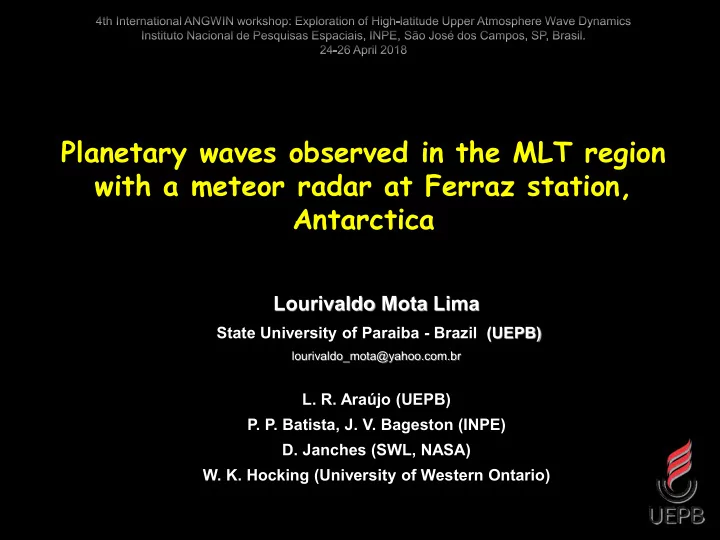

Planetary waves observed in the MLT region with a meteor radar at Ferraz station, Antarctica Lourivaldo Mota Lima State University of Paraiba - Brazil (UEPB) lourivaldo_mota@yahoo.com.br L. R. Araújo (UEPB) P. P. Batista, J. V. Bageston (INPE) D. Janches (SWL, NASA) W. K. Hocking (University of Western Ontario)
Structure and dynamics of the Earth’s atmosphere radiative, Magnetosphere dynamical, processes thermal, chemical, and electrodynamical Sun and geomagnetic processes IONOSPHERE 110 km MLT region Mesosphere-Lower Thermosphere Middle 60 km 10 km Low Meteorology Atmosphere
Planetary Waves Planetary waves are propagating large scale disturbances with low zonal wavenumbers. • Typically planetary waves assume periods of ~2, 4, 5, 10, and 16 days in the MLT region • Oscillations with a period of ~ 6.5 days are also observed In the equatorial region, due the small Coriolis effect, atmospheric waves acquire a different character, allowing the propagation of some distinct wave modes like • Kelvin wave eastward • Mixed Rossby-gravity wave westward
Planetary Waves Quasi-stationary Rossby waves are the dominant disturbances in the extratropical winter stratosphere and lower mesosphere Stationary Rossby waves with low zonal wavenumbers (typically wavenumbers 1–3) can propagate vertically where the background zonally averaged zonal wind is westerly. Conservation of angular momentum is the restoring force that governs the wave dynamics. Traveling planetary-scale waves can achieve high amplitude in the MLT. The periods of traveling waves cluster around periods associated with atmospheric normal modes.
Data used in this study In this work were used equatorial measurements of the meteor winds, which has been recorded from February 2011 to mid-February 2012. https://commons.wikimedia.org/wiki/File:Mapa_bases_antarticas_brasil.pn The winds were collected from a from meteor radar at Ferraz (62.1 S, 58.4 W), station Antarctica. g Free license
Data Series Hourly zonal and meridional winds
Mean winds
Wind Spectra
Quasi-two-day wave (summer 2011/2012) The quasi-two-day wave is a prominent feature of the MLT region, which maximize soon after the summer solstice. April 2005 to December 2008 Tunbridge and Mitchell, 2009
Vertical wavelenght São João do Cariri z = 40 km Cachoeira Paulista z = 65 km
5 day wave (summer 2011) April 2005 to December 2008 Day and Mitchell, 2010
10 day wave (winter and spring) Cachoeira Paulista z ~ 50 to 104 km
16 day wave (summer 2011) Day and Mitchell, 2010
Vertical wavelenght São João do Cariri z ~ 55 km (April–June), λ z ∼ 80 km (August–September) λ z ∼ 50 km (October–December)
Summary Wind measurements from meteor radar at Ferraz station, Antarctica obtained from February 2011 to mid-February 2012, have been used to examine the planetary wave activity in the upper mesosphere and lower thermosphere MLT region. The presence of planetary wave oscillations with periods around 2 and 5 days have been observed during summer. From late autumn to late spring we have observed presence of waves with periods of around 10 and 16 days. Thank you for your attention!
Recommend
More recommend